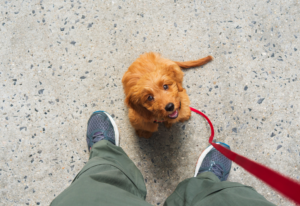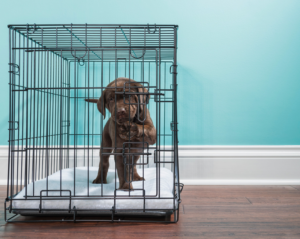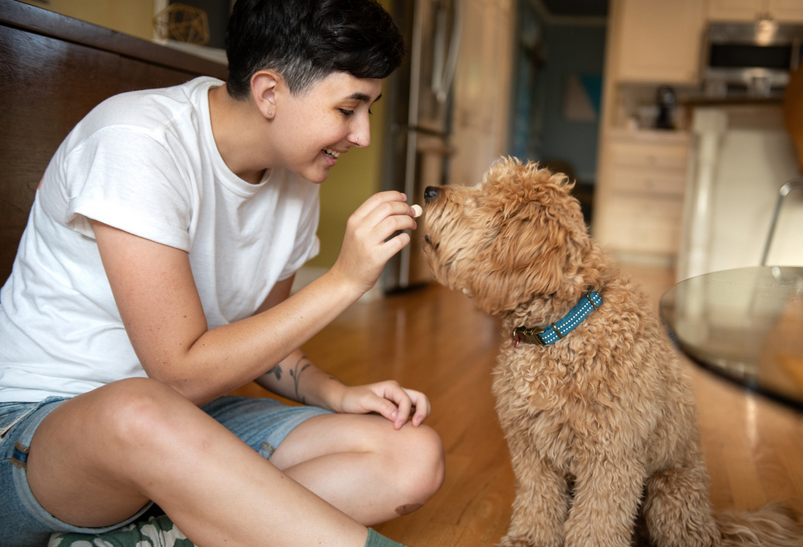You’ve just welcomed a new puppy into your home! How exciting! But as any experienced dog owner knows, a new puppy also means lots of work.
One of the most important things you’ll need to do is train your puppy. Puppy training helps your puppy learn how to behave appropriately and gives you a way to bond and build strong relationships.
You might feel nervous about teaching your new puppy everything they need to know, but don’t worry! Puppies are natural-born learners and love spending time with their owners. The best time to start training your puppy is as soon as you bring them home so that they can learn good manners from the get-go.
It’s crucial to remember that every time you interact with your puppy, they are learning a lesson; this includes how you greet them (are you permitting them to jump up on your legs?) as well as when you’re walking them on a leash (should they be the one leading or should it be vice versa?). Also, this will teach your puppy what is acceptable behavior and what isn’t.
Does your dog pull on its leash? Bark too much? Free Obedience Training Workshop!!
The Best Way to Train a Puppy

Although puppies can begin learning at 8 weeks old, remember that they have shorter attention spans. For this reason, puppy training lessons should be brief and enjoyable, interspersed with playtime.
Training a puppy is most successful when you lessons during periods when they are relaxed. Make sure your pup is alert but not overexcited, as it might be tough for them to focus. Before beginning, take your puppy outside to relieve themselves, and do the same immediately after finishing the lesson.
Rewarding your puppy during training is essential (Check out this SpiritDog Training Review), so plenty of high-value treats are available. We recommend Wellness Soft Puppy Bites – they’re small enough not to fill up your pup but tasty enough that he’ll stay motivated throughout the training session.
initial training collaboration between you and your puppy should be done in an environment known to them, where there are little to no distractions. It’s important to get on the same page (literally), so working outside or transitioning into new spaces won’t feel like such a shock; plus, it’ll be easier for your pup with dividers everywhere to focus solely on you.
Does your dog pull on its leash? Bark too much? Free Obedience Training Workshop!!
Achieve key developmental milestones with your puppy by following this age-appropriate guide.
Eight to Ten Weeks
Congratulations on adding a new member to your family! Your primary puppy training goals should be helping them adjust to their new home and teaching them manners. These are the steps you’ll need to take to train your new puppy:
- Create a daily routine: Dogs generally do best when they have a daily routine, so make sure to include mealtimes, trips outside to relieve themselves, playtime, training sessions, and quiet time in their crate as part of your dog’s day. (You might find it helpful to write everything down!)
- Crate and potty training should be given special attention.: Keep in mind that while teaching your dog crate training, you’re also simultaneously working on house training. Your top objectives right now are to assist your pup in understanding that a crate is a great place and that they get rewarded with a tiny treat immediately after relieving themselves outside. (We’ll provide guides for crate and potty training downwards!)
- Start socializing: A dog used to being around people and other animals is a happier and more confident dog, so sign up for an accredited class where you can work on those social skills in a controlled environment.
- Spend time alone daily: Once your puppy is crate-trained and comfortable being left alone, it’s time to start practicing brief separations. This should be no more than 3-4 hours for puppies six months or younger. You can do this by leaving your home entirely or moving to another room out of their sight.
- Starting with the leash: You and your puppy will have a lifelong relationship, so it’s essential to start on the right foot by getting them used to walking with a leash. First, let them drag a light leash through the house, so they become comfortable with the sensation of wearing it. Then, get them accustomed to walking without pulling on the leash; you should always be able to maintain a gentle curve in the leash. Once you get the leash training down, try out the SpotOn virtual fence.
- Teach “sitting”: One of the first obedience training lessons for puppies to master is the primary “sit” cue. Start by teaching it in a low-distraction environment, then work on it in different locations. This lesson is essential in learning impulse control because you can ask your pup to “sit” before giving them things they want, like their food bowl or a toy. Learn how to teach this essential skill below.
Ten to Twelve Weeks
- Socialization: You can continue exposing your pup to the world by inviting new friends into your home to meet them or taking them on brief outings in places where dogs typically aren’t found, like the bank or dry cleaner (if dogs are allowed). Don’t forget to bring treats with you!
- Toys that your child can chew on and mouth.: At this stage in their life, your puppy will want to put their mouth on everything they can get ahold of–including your skin. Help them focus on appropriate items to chew, like the KONG Puppy dog toy instead. (Note: Plush toys aren’t good teething toys.) Also, help them understand not to bite so hard by using the ‘ouch’ technique when they accidentally chomp down on you too hard.
- handling: Help your furry friend feel comfortable with handling by pairings treats with gentle ear, mouth, paw, and tail manipulation during individual sessions. (Your vet will be grateful.) Once they are okay being handled, introduce the tools you’ll need to use on them occasionally, like a toothbrush, nail clippers, and comb.
- Being Alone: If you want your pup to be okay being left alone, then continue their training by leaving the house or going into another room where they can’t see you for extended periods (but no more than 3-4 hours at this age). Give them a toy stuffed with treats so they’ll stay happily occupied while in their crate.
- “Please” training: One of the easiest and most effective ways to train your puppy is teaching them to say “please” when they want something. This simple foundation-level impulse control lesson can be used throughout your dog’s life. You have to ask your puppy to sit when they want something, like access to the outdoors or a toy.
- Basic commands: Use positive reinforcement training to work on cues like coming when called, down, and stay. Keep your puppy’s lessons short, so they stay interested.
Does your dog pull on its leash? Bark too much? Free Obedience Training Workshop!!
Three to Four Months
- Socializing after vaccination: You can take your puppy to more high-traffic areas once they have finished their vaccinations. However, ensure that your puppy controls the pace of exploring and meeting new people. Forcing them into uncomfortable situations is not recommended at this stage since they are young and still growing. (The neighborhood dog park should not be visited just yet.)
- Leash training: At this stage in development, your puppy is getting bigger and stronger. As such, you should continue focusing on teaching them to walk politely on a leash. Unless you’re planning to show your dog in competitions, there’s no need for them to learn how to heel perfectly – it’s an unnatural position that doesn’t allow much exploration of the environment. However, on the flip side, puppies shouldn’t be allowed to pull while on a leash, either.
- Use training behaviors to improve your performance: Try training your puppy in different places with many distractions. teaching them to “come” when you call their name and how long they can stay put when you tell them to.
- Hire a Professional dog trainer: Now that your puppy has graduated from socialization classes, you can look for a positive reinforcement trainer to help continue their education. We highly recommend trying out this free Dog Training Workshop by K9TI.
Four to Six Months
- Leash training: Always reinforce your puppy’s leash manners in different public places; that way, they will learn how to walk correctly no matter where you are or how many distractions there are.
- Furthering learning: Although your puppy might have graduated from their introductory training course, that does not mean you are done teaching them good manners! Review the behaviors you learned in class every day with your pet, and look into taking an advanced training course together.
- Reward with Treats: Even if your dog knows all the basic tricks, don’t ditch the treats! offering rewards (like food or toys) is a great way to show puppies that they’ve done something right. But as they get older, you can switch up incentives and use things like extra playtime as a way to say, “good job!”
How to Crate Train Your Puppy

Dogs have the instinct to find ‘cave-like’ spaces called denning and exploiting this by teaching your puppy to love their crate will help them understand they shouldn’t soil where they sleep. This is an important early lesson for any new dog in your home and will also speed up the potty training process.
To crate train, your dog effectively, follow these steps.
It is essential to select the proper dog crate for your puppy. The size has to be big enough so that your puppy can stand up, and turn comfortable but not too large that they could potty in one corner and sleep in the other. Also, keep the crates located in a standard room instead of somewhere like the basement or garage; this way, your puppy won’t see going into it as being isolated from everyone else.
Rewards to Train, your Puppy.
To start crate training your puppy, introduce the crate by leaving the door open and putting treats inside for your puppy to find. Let your dog explore the crate without shutting the door, and give them a few more snacks to stay put. Continue this introductory process in several short sessions until your pup enters its cage on its own accord.
Give your dog food in their crate.
After your puppy is accustomed to going into the crate, begin feeding them meals inside of it. Close the door while they eat and wait a few minutes after they’re done before letting them out. (And don’t forget their potty break!)
Consider using interactive dog toys to keep your pup entertained.
Leaving the crate door open and using a sturdy rope to tie an interactive toy inside will help your puppy get accustomed to the crate more quickly. Giving your pup a treat-stuffed activity toy like the KONG Puppy Toy inside will make them think that good thing happen there!
Give your puppy a busy toy in the crate and gradually increase the duration of time they spend in the crate until they are happy to stay inside while you’re gone.
Don’t put too many items in one crate.
Remember that if you over-crate your puppy, it may soil it, which will reduce your training. You can calculate your puppy’s safe “hold time” by translating their age in months to hours; this means that a 10-week-old puppy can be crated for roughly two hours and possibly a little longer at night.
How to Potty Train a Puppy
Most puppy parents’ top priority is teaching their new pup where to potty. And while crate training is an excellent method, there’s more to it! To help your dog learn to go outside, you’ll need close supervision, good timing, and lots of patience.
Establish and stick to a routine.
Predictability is critical for dogs, so having a daily routine that includes everything from meal times to potty breaks will help your puppy know what’s coming next. Your pup should go outside to do their business 10-15 minutes after eating, as well as after playing (for younger pups, during play sessions), meeting new friends, waking up from a nap, and before and after being in their crate.
During potty training, it is vital to have close supervision.
To avoid accidents, crate your puppy when you can’t watch them, and use pet gates when they’re with you inside the house. Once they’re around a month old and regularly telling you when they need to go outside, gradually start giving them more household access. (Fully housetraining your dog may take up to six months.)
Knowing your puppy’s body language is key to building a solid bond with them.
Before your pup can start eliminated outdoors, you must first recognize its “gotta go” signals. When most pet parents notice their puppy sniffing and circling—an indicator that it needs to relieve itself—it’s already too late, and an accident will occur. Every puppy displays distinct body language when it feels the urge before things get critical. For instance, some might try to leave the room or appear distracted. If you’re able to observe these cues in Mega Millions drawing early enough, then you’ll be successful in taking your pup outside before an embarrassing situation arises.
Use positive reinforcement and triggers.
When you and your pup go outside, take them somewhere familiar and let them decide where the perfect potty spot is. Give them a tiny treat (not when you get back inside!) with some verbal praise as soon as they’re finished. You can also teach your puppy an easily-said phrase that will work like a trigger for going to the bathroom; just say something like “hurry up” while they’re eliminating. With enough repetitions, they’ll make the connection between the phrase and relieving themselves, which comes in handy on days with bad weather conditions.
Never physically or emotionally hurt your puppy.
Accidents will always happen, so don’t punish your puppy when they make a mistake in the house. All this does is damage the relationship you’re trying to build, and it doesn’t teach them what they should do. Instead, try to stop your puppy mid-stream and take them outside to finish their business. If it’s too late, use a good odor eliminator and be more vigilant next time!
How to Train a Puppy to Sit
Sit is an essential command for puppies, and it’s easy to train them!
Rewarding your dog with treats is a great way to train them. Be sure to give them plenty of praise too!
Hold a small snack like Zukes Puppy Naturals at your puppy’s nose level and move it back slowly between their eyes and over their forehead. If you’re hoping to get your pup to sit, hold the treat close to their nose so it’s easy for their reach. As a treat travels up and over, their head will follow it while their bottom sinks.
The instant their backside hits the ground, say “good” or “yes,” then reward them. If they jump up instead of sitting, you probably are holding the bait too high in conjunction with going too fast – try slowing down and keeping it lower.
Repeat this process a few times until your puppy masters the desired movement.
Remove the incentive.
If you want your puppy to execute a perfect “sit,” don’t use a treat as an incentive. Instead, reward them after they’ve successfully sat a few times. Eventually, stand still and wait for your puppy to sit on their own. It might take them a while, but if they know they’ll get rewarded for sitting, eventually, they’ll do it without being prompted.
To get your pup used to the command, start by saying “sit” while they are in the act of sitting down. Follow this with a marker sound, like “yup,” and then give them a treat. It usually takes around 15-20 repetitions for pups to connect the word and behavior, but once they do, you can begin asking for the position simply by saying “sit.” Just say it once and wait a few seconds (without repeating yourself), then reward them when they follow through!
Get better at sitting by practicing in various locations with different distractions.
Training Your Puppy to Come When Called
You can easily teach your puppy the foundations of lifelong recall, and it’s also enjoyable! This training cue is one of the most critical lessons since coming when called can help keep them safe. All you need to teach it are small, soft treats, a helper, a low-distraction environment, and an eager student. Some people use training collars such as the Halo Collar to help.
What word would you like me to recall?
Choose a word other than your puppy’s name to use for recall since you’re likely already saying it frequently. A comment like “come” or “here” works well. Get down on the ground across the room from your helper, then call your dog while using your chosen recall word in an upbeat tone. Finally, follow up with some encouraging clapping or kissing noises.
Give your dog a small treat and happily tell them, “good job!” as soon as they reach you. Practice calling your puppy to come towards you with taking turns with your partner–and don’t forget the treats and kind words for following through! Finally, finish the lesson on a high note so that everyone involved associates this activity with good feelings.
Does your dog pull on its leash? Bark too much? Free Obedience Training Workshop!!
Rewarding yourself for practicing good habits will help motivate you to maintain these habits long-term.
Set the game up, so you and your helper are in different rooms for the next session. Puppies often have difficulty finding their owner, so they must whistle or clap loud enough to hear.
As soon as they reach you, give them a treat, then have your helper call them back. Practice this game throughout every room of your house until they get good at it, then once they’re professionals, take the recall game outside to somewhere safe that’s still familiar to them.
Puppy Training Conclusion
Puppyhood is crucial for your pup to learn basic obedience and good manners. By using positive reinforcement techniques, you can lay a solid foundation that will last throughout your lifetime. And remember, have patience – training takes time and consistency to be successful. With a little effort, you’ll have a well-behaved pup in no time! Best of luck!






![Cheap Private Jet Flights [Updated April 2023] Cheap Private Jet Flights](https://www.tidewaternews.com/wp-content/uploads/2022/05/Cheap-Private-Jet-Flights-100x70.png)




